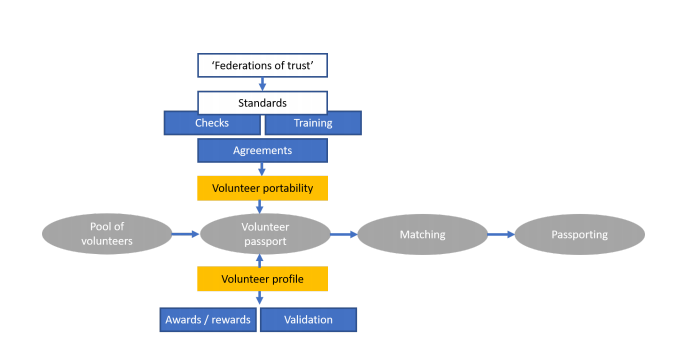Volunteer Passporting Research Report
Tags: Report
26th February 2025
0 Likes

This report was prepared by Research Works for the Department of Digital, Culture, Media and Sport, published in April 2021
Executive Summary
The concept of volunteer passports has long been a topic of debate in the volunteering community. Many stakeholders have embarked upon ‘passporting’ initiatives in the past, reaching varying stages of maturity in their development and implementation. The renewed focus on the vital importance of volunteering during Covid-19 has provided a fresh impetus to consider volunteer passports and their potential for supporting and unlocking further voluntary activity.
This study was commissioned to help build an evidence base for understanding:
1. The present landscape of volunteer passports and passporting;
2. Areas of demand and opportunities for volunteer passports and passporting to support volunteering, as well as the perceived challenges involved.
The research included two main elements: a literature review and primary qualitative research with volunteers, volunteer involving organisations (VIOs), digital platform providers and stakeholders. Qualitative research was carried out with 58 respondents in total, who were interviewed through a mix of group discussions and individual or paired depth interviews.
The research found a wide range of volunteer passport and passporting initiatives in the UK and internationally, underscoring the diversity of meanings attached to this concept. Across this diversity, past and present volunteer passport and passporting initiatives shared two broad aims: to improve ‘volunteer portability’ understood as easy movement of volunteers across different VIOs and roles; and validate and value volunteers’ experience, skills and contribution:
● Passporting initiatives striving for volunteer portability often involved networks of organisations developing a joined-up approach to volunteer recruitment, onboarding and management. These initiatives focused on passporting systems, mechanisms and processes that enabled volunteer portability, rather than passports as ‘products’.
● Volunteer passports aiming at validation were typically volunteer-owned ‘products’ that provided a portfolio of the volunteer’s experience, knowledge and skills acquired through volunteering.
● There were also passporting initiatives that straddled portability and validation aims, for example, training-based volunteer passports.
Across these different types of volunteer passport and passporting, there was some consistency in key elements they involved. These included:
● ‘federations of trust’ as networks of organisations developing a joined-up volunteer approach;
● shared volunteer vetting and training standards and agreements and sometimes also centralised delivery of vetting and training;
● shared pool of volunteers;
● matching of volunteers with volunteering tasks across the network;
● a volunteer profile/ portfolio offering a record of their volunteering and skills;
● routes to validate volunteer learning, for example, through certificates or qualifications;
● volunteer reward schemes which were sometimes linked to volunteer profiles, so rewards could be redeemed against time spent volunteering.
However, different volunteer passport and passporting initiatives combined these elements in different ways, rather like jigsaws, and did not always include all these elements. In addition, some were digitally enabled, so also required particular digital infrastructure as detailed in the report. Some key drivers behind the development of such initiatives and benefits they sought to achieve included: achieving quick and large-scale mobilisation of volunteers; improved volunteer experience and cost savings for VIOs through reduced duplication in volunteer recruitment and onboarding process; greater consistency of standards in volunteer vetting, training and skills resulting in quality assurance; and supporting, developing and valuing volunteers. The research also underlined some key challenges involved in volunteer passporting initiatives, such as: the difficulty in aligning standards across diverse organisations, geographical limitations to volunteer portability, and concerns that portability may loosen VIOs’ relationships with their volunteers.
The research with volunteers, VIOs and stakeholders highlighted what they perceived as key areas of demand for volunteer passports and passporting to support volunteering. Specifically:
● Portable ID and DBS checks were welcomed as a core element of a potential volunteer passport to reduce duplication in volunteer recruitment and onboarding;
● Having a shared pool of volunteers was perceived as important for particular types of volunteering: emergency, event-based, micro, place-based, task-based volunteering;
● Standardisation of volunteer training and skills was of interest to some in two areas: standardisation of entry-level volunteer skills and sector-specific standards for specialist skills;
● Validation of volunteers’ experience and skills was perceived as beneficial for particular groups of volunteers, where volunteering was also a potential route to employment.
The study further identified some key success factors and design considerations for volunteer passport initiatives to benefit the voluntary sector. This included: commonality of interests needed to develop ‘federations of trust’; flexibility to allow for adaptations to diverse sectors, VIOs and volunteers; sustainability in terms of the voluntary sector resource required to develop and maintain passporting schemes; credibility within the voluntary sector; open data technology and integration with existing volunteer management platforms and infrastructure; accessibility for users and alternative systems for those not using these platforms; ensuring volunteer-controlled passport product; and the ability to manage risk in the shared volunteer management system.
The report that follows provides detailed findings on the areas above. Following Chapter 1 which outlines the research objectives and methodology, Chapter 2 suggests a possible taxonomy of types of volunteer passports and passporting, key drivers, elements and models involved, and related practices which are part of the passporting landscape. Chapter 3 details experiences of existing volunteer passport and passporting initiatives: their perceived benefits, as well as difficulties and challenges involved. This chapter concludes with a discussion of broader views on the demand for volunteer passports and passporting from the perspective of volunteers, VIOs, digital platform providers and stakeholders. Chapter 4 discusses expectations of how the government could support volunteering through volunteer passports. Chapter 5 offers conclusions and a synthesis of key findings, also pulling out comparisons across different voluntary sectors, including: sport, culture, health, community action, education, youth and police volunteering. Throughout these chapters, the study seeks to provide a basis for a shared understanding of different applications of volunteer passports and passporting, rather than promote any single model.
To read the full report, please download the attachment below.
